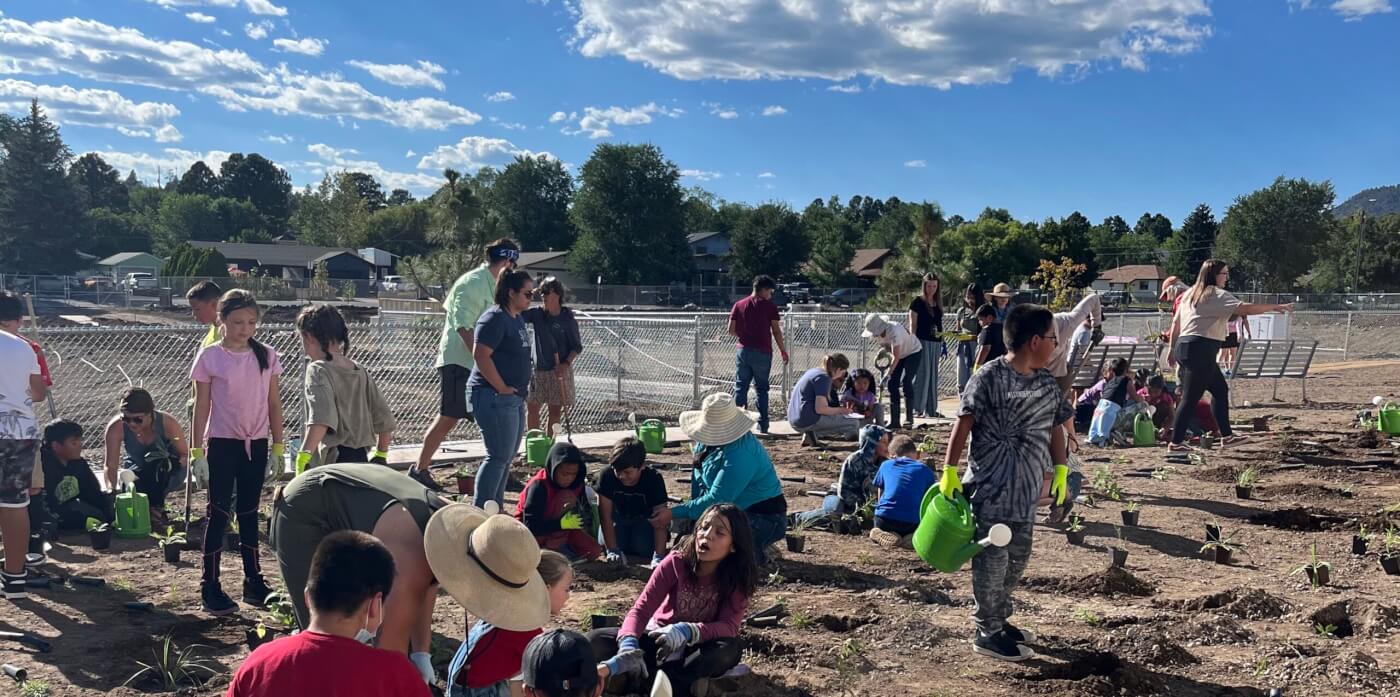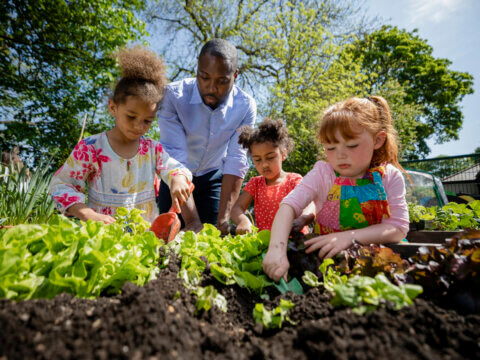In Flagstaff, green schoolyards sprout after climate-related disasters
Climate-related fires and floods are all too common these days for cities in the western United States. Unfortunately, this is precisely the story of Flagstaff, Arizona and for the students at Killip Elementary. But today, Killip Elementary is a model of what can sprout, literally, after traumatic natural disasters.
On July 21, 2019, a wildfire began that would come to be known as the Museum Fire. The fire was not fully contained until August 12, by which point it had ravaged much of northern Flagstaff, burning over 1,900 acres. In and of itself, the wildfire was devastating to nearby communities and to the landscape. But years of drought, followed by extreme rain, made the situation even worse.
“Everybody was on edge because we knew the burn scar was there,” said Gayle Gratop, Assistant in Extension at Coconino Cooperative Extension at the University of Arizona. “Without any vegetation to keep the water in the soil and after years of no rain, the community knew that when we finally got rain, it would be devastating.” And, it was.
Two years after the fire, between 2 and 3.5 inches of rain fell on the Museum Fire burn scar within a few hours. The rains continued, leading to several major flooding events in one summer.
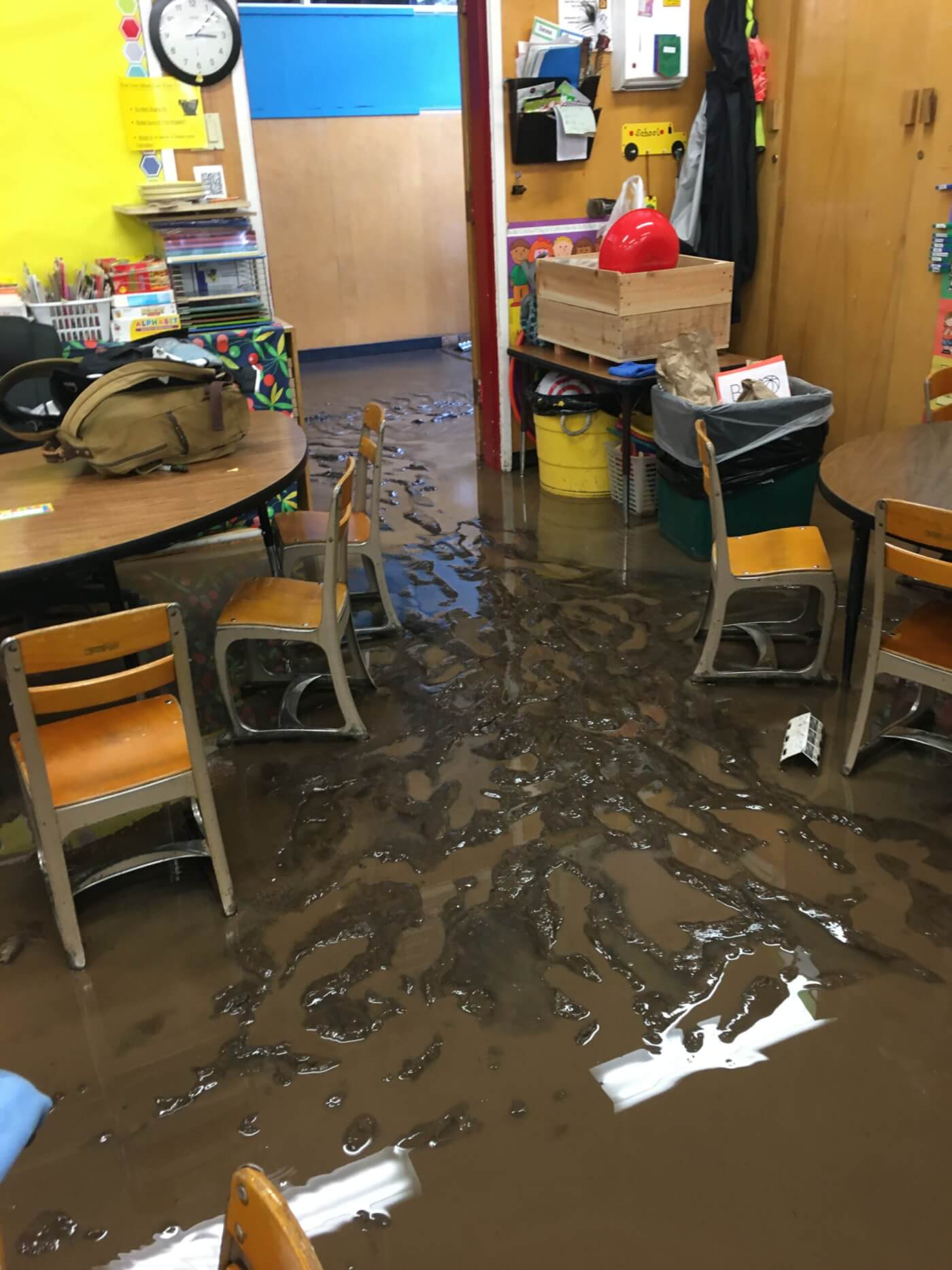
Inside Killip Elementary classroom after the 2021 flood.Photo credit: Sheryl Wells, Killip Elementary
“It looked like the Grand Canyon rapids running down the street,” said Gratop.
The community was devastated. Roads were closed, storm drains clogged and homes destroyed. A local school in Flagstaff’s Sunnyside community, Killip Elementary, was flooded, making the building unsafe for use. The students were displaced, uprooting the entire school population to an unused building for the 2021-2022 school year.
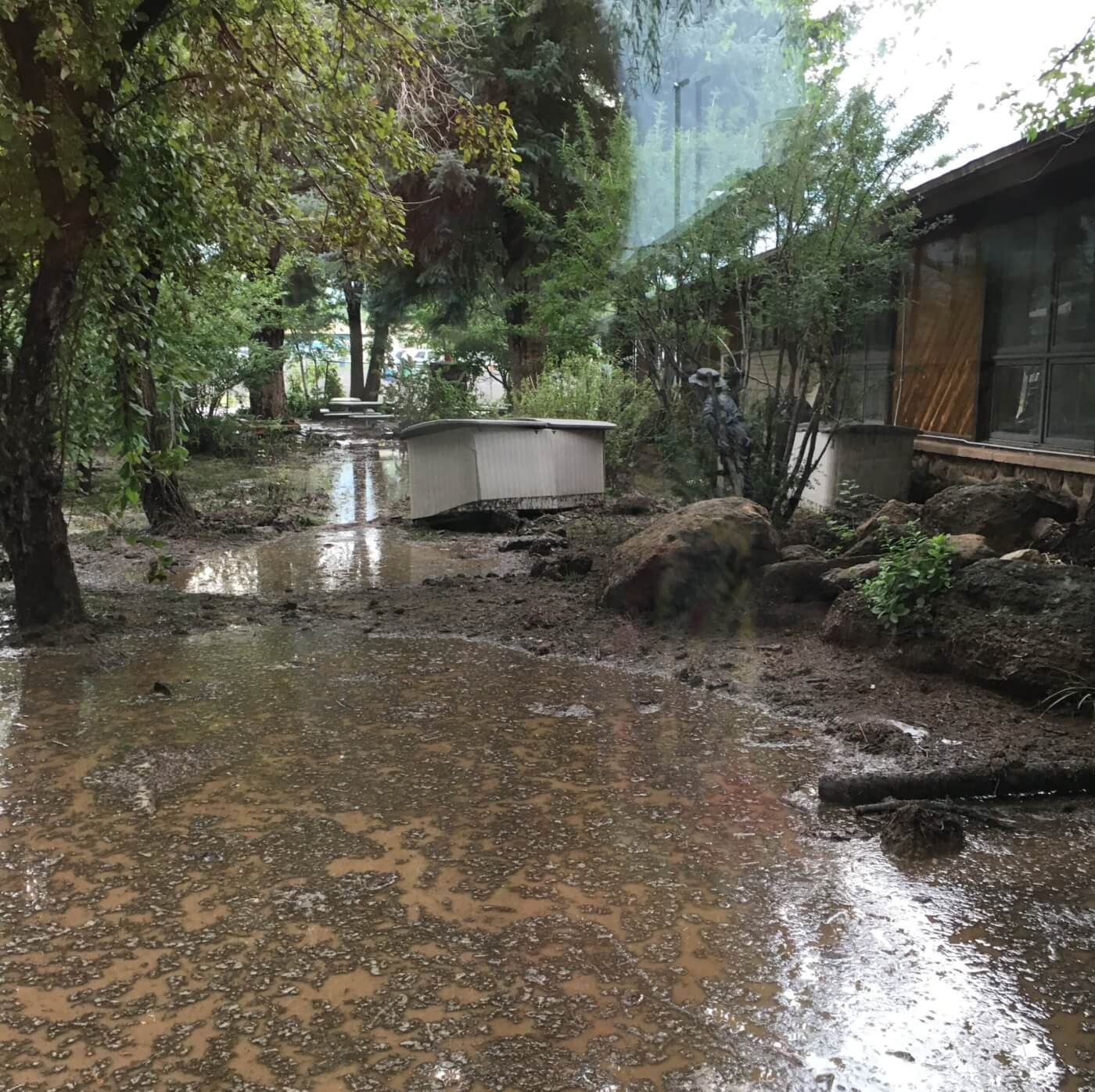
Flooding behind Killip Elementary School in 2021.Photo credit: Sheryl Wells, Killip Elementary
“It was pretty traumatic,” said Gratop, whose offices are right across the street from Killip Elementary.
But this is where the story takes a different turn, thanks to local collaboration and shared commitments to adapt to the effects of climate change. Prior to the floods, the school district already had plans to rebuild Killip Elementary. The floods pushed decisionmakers to incorporate elements of stormwater retention and climate resiliency in their plans for Killip’s new building. As a result, Killip Elementary’s new schoolyard now serves as a stormwater detention basin designed to manage millions of gallons of stormwater for flood protection.
Killip Elementary is the first project of what is now a broader district-wide green schoolyard plan between the City of Flagstaff and Flagstaff Unified School District (FUSD). Flagstaff was selected in 2021 as one of 11 cities to receive training, seed funding, and technical assistance through Cities Connecting Children to Nature (CCCN), a joint initiative of the National League of Cities and the Children & Nature Network.
The Flagstaff Green Schoolyard team is composed of representatives from the city’s Sustainability Office, FUSD school system, local nonprofits such as Terra BIRDS, the University of Arizona Extension program, and local community leaders. This collaborative approach allows the team to work cross functionally to bring the benefits of green schoolyards to students and their families, while advancing climate resilience for the city at large.

A Killip Elementary student finds a bug during a volunteer event that was organized to plant a native pollinator garden.Photo credit: Terra BIRDS
“One of the reasons Flagstaff was selected to join the CCCN Green Schoolyard cohort was their direct interest in using green schoolyards to help mitigate climate-related disasters,” said Mikaela Randolph, Technical Assistance Consultant for CCCN. “There is a clear vision of how schoolyards can align with their respective climate action plans while also serving broader community needs such as outdoor learning, park access and more.”
Thanks to the team’s collaborative work, the new green schoolyard at Killip Elementary serves multiple purposes:
- It addresses climate resiliency by serving as a detention basin and housing a native pollinator garden.
- It serves as an outdoor learning environment, acting as a critical component of the school’s STEM program.
- It supports community food security by serving as a center for growing food and gardening.
“Historically, Killip has a rich history of growing food for the community. When the school was rebuilt, it was really important to the community that the tradition continued for the neighborhood,” says Danya Gorel, Outreach Coordinator for Terra BIRDS, a nonprofit that works with Flagstaff schools. “This is an opportunity for the students and community to leave a legacy.”
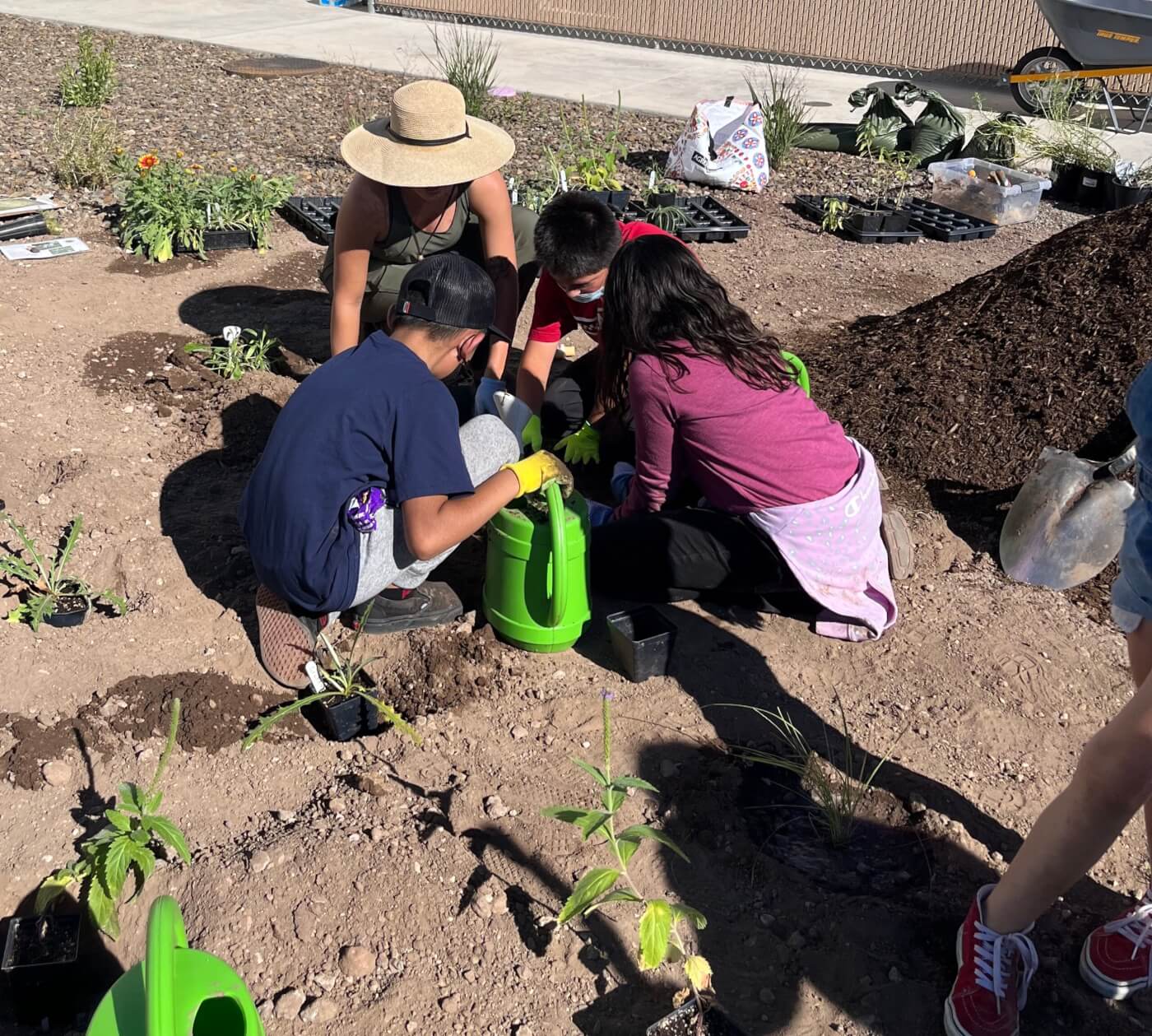
Students and teachers at Killip Elementary incorporate STEM curriculum into hands-on learning while planting the new green schoolyard.Photo credit: Terra BIRDS
“Killip has been provided an opportunity to build and expand on the community garden concept,” said Killip Elementary Principal Joe Gutierrez. “With the help and support of the community, we are able to provide our students with a 21st-century environment.”
Access to key decision-makers was essential in helping the Flagstaff Green Schoolyard team ensure the new Killip Elementary building achieved the many interests of local students and community members while also meeting climate-related goals.
The addition of a native pollinator garden to Killip’s schoolyard is an example of how that access and collaboration helped further connect shared goals. The Green Schoolyard team was able to get a piece of the schoolyard that was slated to be turf and turn it into a native pollinator garden with assistance from students who participated in a Wildlife Gardener group.
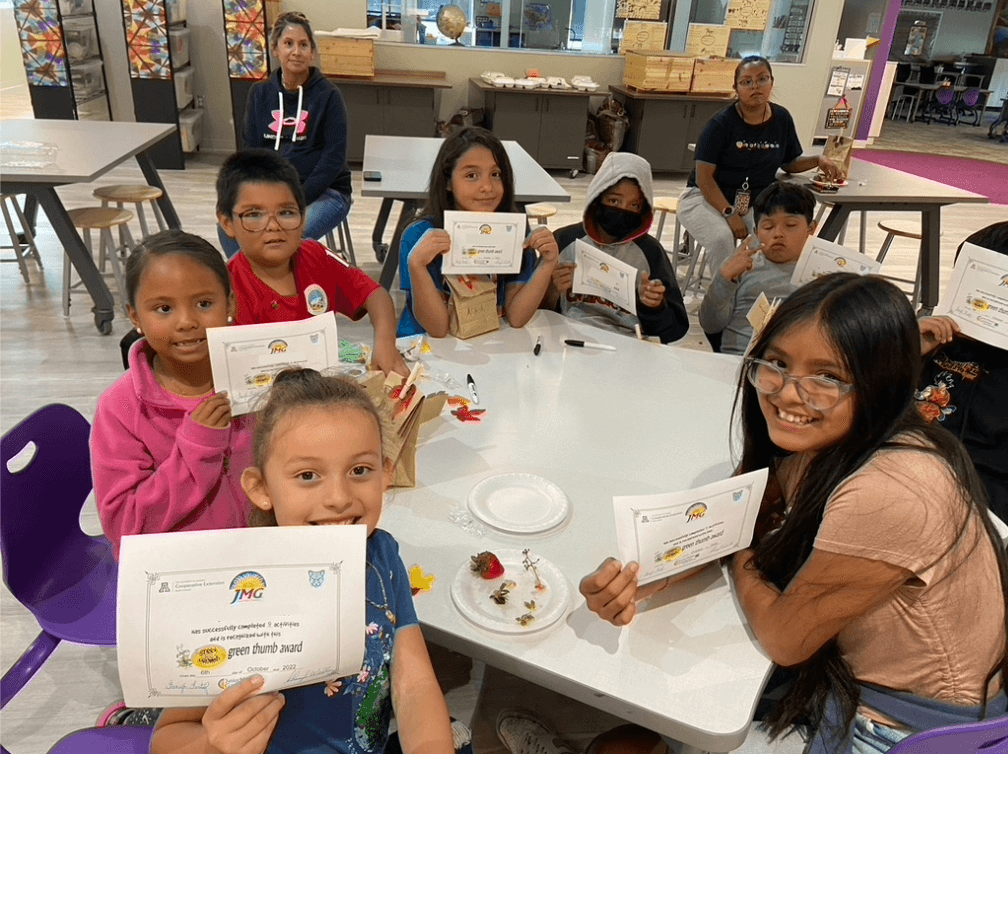
Wildlife Gardener students from Flagstaff’s Killip Elementary. Participants plant food and native pollinator gardens in their green schoolyard, which also helps address climate-related issues in their city.Photo credit: Master Gardener Program at Coconino Cooperative Extension, University of Arizona
“We planned the garden with students through an after-school gardening program. Kids learned about the importance of native plants and water conservation,” said Gratop. The program addresses climate resiliency while also supporting the school’s STEM objectives and specifically meeting goals outlined in the FUSD Climate Action Report.
“The Flagstaff Green Schoolyard team got face time with architects and engineers. We were engaged in conversations with them while they were building the school, telling them what we wanted,” said Gorel.
Elizabeth Taylor, Terra BIRDS Board member and Flagstaff Green Schoolyard team member, believes that years of conversations are what led the schoolyard to incorporate so many different goals that aligned with city, district, community and local school objectives.
“We’ve had a long history of communicating with one another,” said Taylor. “It’s in the interest of the community to find people to collaborate with. The floods at Killip pushed it. Things got expedited. But that history of conversations was already there.”
Those conversations have paid off in regard to advancing climate resiliency; both the city and the school district have climate action plans in place. “There have been many conversations with the city, the county and the school districts around climate action,” said Summer White, Waste Reduction and Food Systems Coordinator for the City of Flagstaff Sustainability Office. White says those plans have been critical to moving this project forward. “Many may say it’s just a document. But these are guiding documents that come from the city and the district,” said White. “We can use those guiding documents to move forward and create more agreements and collaborations.”
Killip Elementary: Honoring the Past, Building for the Future. This video from Flagstaff Unified School District highlights community partnerships and collaboration. Although it doesn’t explicitly discuss the Killip schoolyard, it is fully representative of the process, the team and the partnerships that led to the incorporation of a green schoolyard at Killip Elementary School.
Gorel agrees. “The first, critical step is saying you want to do something and bringing agreements and people together. And then you go out and find the money to make it happen.”
Both Gorel and White have relied on the city and the FUSD climate plans to gain additional funding to further local projects. The Flagstaff Sustainability Office recently received a USDA grant to create a food action plan, which will incorporate green spaces, green agriculture and schools, because of their work with Killip and the district’s Green Schoolyard plan.
Terra BIRDS partnered with the City and FUSD to receive a Partners for Places (P4P) mini-grant from The Funders Network for a district-wide green schoolyard assessment. The grant supports Terra BIRDS in conducting a district-wide survey of 15 designated green schoolyard sites. The survey will be completed by a youth crew and local volunteers and will be presented to the City and FUSD in the spring of 2023.
Gorel, who supported Terra BIRDS’s Executive Director and Development Director in writing the grant, said she used FUSD policies and specific bullets from the city’s Carbon Neutrality Plan — passed in 2021 after a declaration of a climate emergency — as proof that the City and FUSD support the proposed district-wide green schoolyard plan. “Getting that proclamation, having that written down, is really a huge game changer for securing funding.”
The Green Schoolyard team doesn’t plan to stop here. The intention is to use Killip as a case study and then move their work to a school district-wide level.
“People need a touchstone,” said Taylor. “And that’s what Killip is. We have an example for the district. With this new assessment, we can see what’s out there and take elements of what we’ve learned from Killip. We can then expand to the rest of the district.”

An element of Killip Elementary’s green schoolyard is aimed at water retention support.Photo credit: Flagstaff Unified School District
“The grand plan is to apply for the larger grant and to get an invitation for hundreds of thousands of dollars to actually execute this assessment,” says Gorel. “So, this pilot grant is really focused on building and strengthening those relationships between funders, the district, the city and nonprofits.”
For the community leaders and residents of Flagstaff, building relationships, developing partnerships and thinking strategically about the future has been an essential part of their success. Taking the time and space to build those relationships is critical.
“When we were selected for the CCCN Green Schoolyard cohort, that gave us time and space to just hold together,” said Gorel. “That can go a really long way in building collaboration and aligning goals.”
“For me, the theme continues to be partnerships,” said Taylor. “We know we need to have comprehensive solutions that are put in place locally but also regionally. It’s created a lot of natural collaboration.”
That theme of partnerships applies across and within the city, too. “As I think of how to enact systems-wide change, I think of it at a city level as well,” says Summer. “I think of how to expand this work out to other departments and engage them in these conversations. How do we expand to Stormwater and Parks?”
The Flagstaff Green Schoolyard team understands they have limited control over fire, rain and other climate-related disasters. But they can control how they engage with each other to help strategically plan, collaborate and mitigate climate impacts for the future. Woven throughout their collaborative work is an aim of supporting local residents, students, community members, and the livelihood of Flagstaff to adapt to what climate change will mean for their city.
- Bridging the fields of children to nature and sustainability and resilience: A Cities Connecting Children to Nature report
- Green Schoolyard Toolkit: Let’s Get Started. A toolkit from Cities Connecting Children to Nature to help cities and districts get started on their green schoolyard plans
- Benefits Wheel of Green Schoolyards
- Climate solutions start in the schoolyard: A National League of Cities’ CitiesSpeak article
-
Network News
Earth Day: Young leaders advocate for change
-
Feature
Nature photographer Dudley Edmondson has a vision for the representation of Black and Brown faces in the outdoors
-
Richard Louv
EARTH MONTH: You're part of the New Nature Movement if....
-
Voices
Placemaking: How to build kinship and inclusive park spaces for children with disabilities
-
Network News
Children & Nature Network founders release report on global factors influencing the children and nature movement


